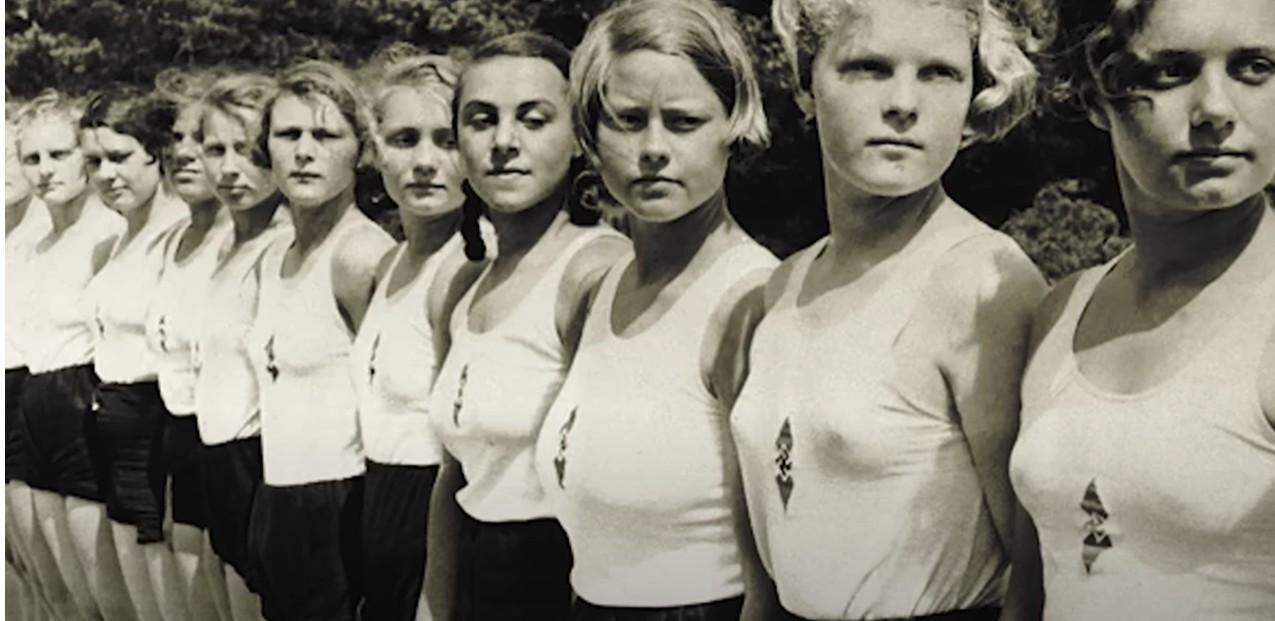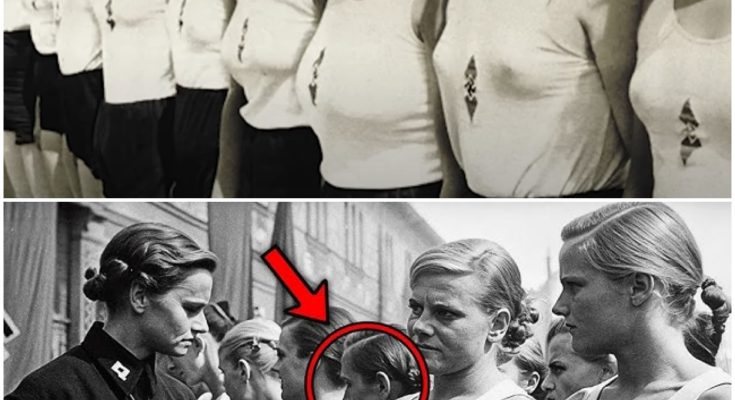Unveiling Hidden Horrors: The Chilling Truth Behind a Photograph from Nazi Germany
At first glance, an old photograph from Nazi Germany appears to be just another historical snapshot—a group of young women standing in neat rows, their expressions a mix of pride and uncertainty, with a uniformed man overseeing them.
However, when historians took the initiative to colorize and zoom in on this unsettling image, they uncovered chilling details hidden in plain sight.
Tiny numbers, inscribed directly onto the women’s skin, revealed a disturbing connection to one of the darkest chapters in human history.
A Closer Look at the Photograph
The photograph, which had been largely overlooked for decades, was part of a collection documenting life in Nazi Germany.
Initially, it seemed like a mundane representation of the era, showcasing young women who may have been part of various propaganda efforts or social programs under the Third Reich. Yet, as experts began to analyze the image with modern technology, the true horror of the photograph began to emerge.
Upon closer inspection, the tiny numbers etched onto the women’s arms became visible. These markings, reminiscent of the tattooing practices used in concentration camps, hinted at a far more sinister reality.

The numbers suggested that these women were not merely participants in a propaganda campaign; they were victims of a regime that dehumanized and objectified countless individuals.
The Historical Context
To understand the significance of this photograph, one must consider the historical context of Nazi Germany. During the regime’s rise to power in the 1930s and 1940s, the government implemented a systematic campaign of oppression against various groups, including Jews, Romani people, homosexuals, and political dissidents.
Many of these individuals were subjected to horrific treatment, including forced labor, imprisonment, and extermination.
The young women in the photograph likely represent a demographic that was both exploited and manipulated by the Nazi regime.
They may have been coerced into participating in state-sponsored programs or used as pawns in propaganda efforts aimed at promoting the ideals of Aryan supremacy and nationalism.
The presence of numbers on their skin serves as a haunting reminder of the atrocities committed during this dark period.
The Discovery Process
The revelation of these markings prompted historians to delve deeper into the origins of the photograph. Researchers began to trace its provenance, seeking to uncover the identities of the women and the circumstances surrounding the image.

This investigative process not only aimed to provide context but also to honor the lives and stories of those who suffered under the oppressive regime.
As the investigation unfolded, historians and archivists collaborated to piece together the fragmented narratives of the women depicted in the photograph.
They sought to understand their experiences, motivations, and the impact of the Nazi regime on their lives. This effort underscored the importance of remembering and acknowledging the victims of history, ensuring that their stories are not forgotten.
The Chilling Implications
The discovery of the numbers on the women’s skin raises profound questions about the nature of identity and the ways in which individuals were stripped of their humanity during the Holocaust.
It serves as a stark reminder of the dehumanization that occurred under the Nazi regime, where individuals were reduced to mere numbers—symbols of oppression rather than human beings with stories, dreams, and aspirations.
This chilling revelation also highlights the need for continued education and awareness about the Holocaust and its implications. As we confront the legacy of this dark chapter in history, it is crucial to recognize the signs of hatred and intolerance in our own time.
The photograph serves as a powerful reminder that the lessons of the past must inform our actions in the present and future.
The Role of Technology in Historical Research
The ability to colorize and zoom in on historical photographs has transformed the field of historical research. Advances in technology allow historians to uncover details that were previously hidden, providing new insights into the past.
This process not only enhances our understanding of historical events but also connects us with the individuals who lived through them.
In the case of the photograph from Nazi Germany, technology played a pivotal role in revealing the chilling truths behind the image.
It serves as a testament to the importance of utilizing modern tools to explore and understand history, ensuring that the stories of those who suffered are brought to light.
Conclusion: Remembering the Past
The photograph of the young women from Nazi Germany is more than just an image; it is a haunting reminder of the horrors of the Holocaust and the resilience of the human spirit.
As we reflect on the chilling details uncovered through modern technology, we must commit to remembering the victims and honoring their stories.
In a world where the lessons of history can often be forgotten, it is our responsibility to ensure that the past is not erased. The numbers etched onto the women’s skin serve as a powerful symbol of the atrocities committed during the Nazi regime, reminding us of the importance of vigilance against hatred and intolerance.
As we continue to explore the complexities of history, let us strive to learn from the past and work towards a future where every individual is recognized for their humanity, dignity, and worth.
The chilling truth revealed in this photograph calls us to action, urging us to remember, educate, and advocate for a world free from oppression and hatred.



